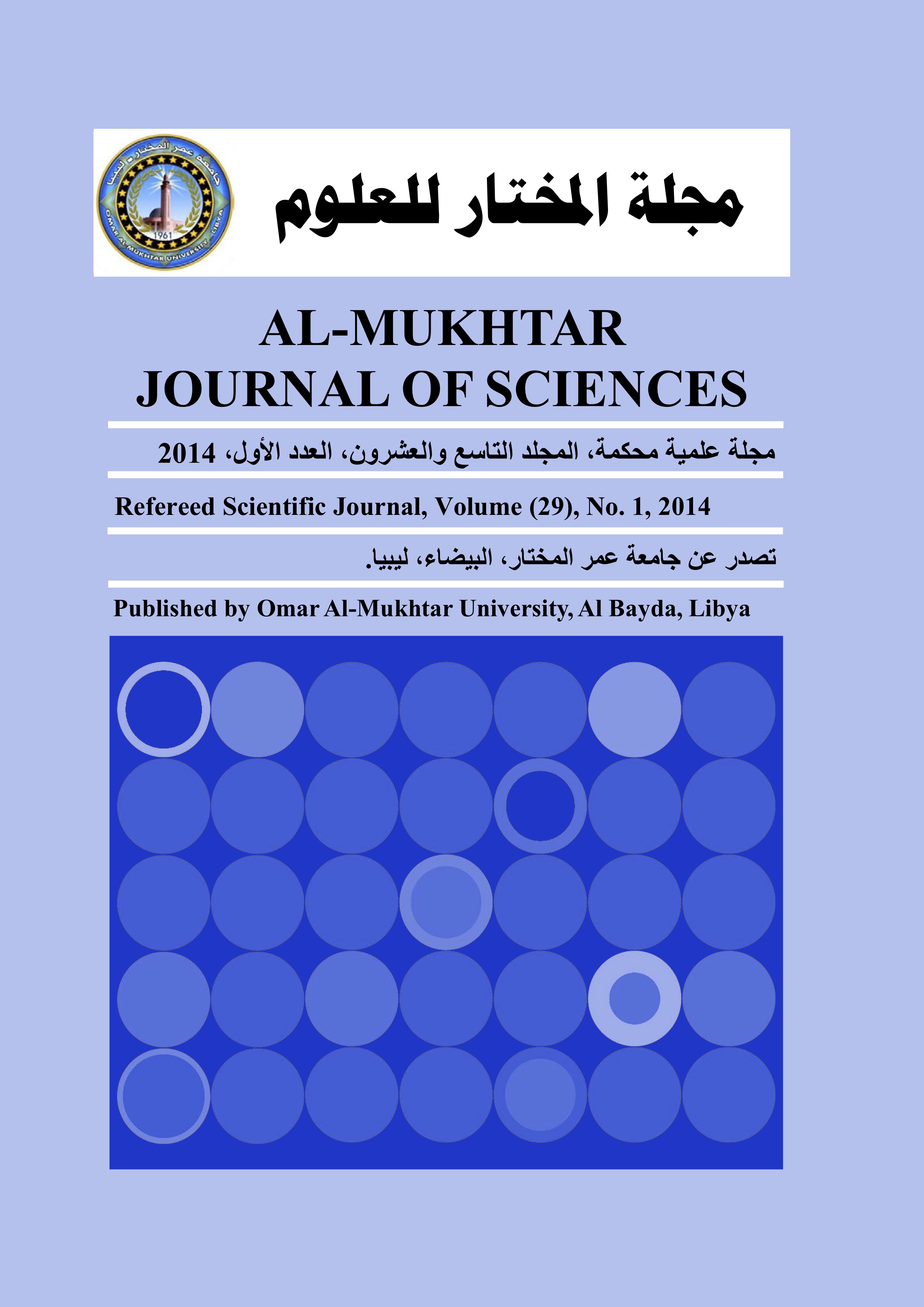Application of Micro EIS in evaluation of soil production rate in Quba-Libya
DOI:
https://doi.org/10.54172/mjsc.v29i1.111Abstract
The purpose of the current study was to evaluate some land of El-Koba area, Al-Jabel Al-Akhder region, Northeast Libya. The evaluation process was carried out through assessing the land capability in the study area using MicroLEIS software. The study area (about 2370 ha) was chosen as it represents the different soil types and land uses prevalent in Al-Jabel Al-Akhder region. A geo-pedological soil survey was initiated, and 21 soil profiles representing the different physiographic units were morphologically described and 58 samples in the field, for some chemical and physical properties analysis. Land evaluation was achieved using MicroLEIS software. Land capability classes S2 (Good) represented about 54.9%, S3 (Moderate) occupied about 37.1% and N (Marginal or Nil) had about 3.8% of the total acreage. In addition, rocky surface occupied 4.2% and did not evaluated. The main limitations were soil factor and erosion risk.
Downloads
References
بن محمود, خالدرمضان. (1995). الترب الليبية، (تكوينها وتصنيفها وخواصها وإمكانياتها الزراعية)، الطبعة الأولى، الهيئة القومية للبحث العلمي طرابلس- ليبيا.
Abd El-Hafith, W. A. (2004). Current and predicted land evaluation by integrating GIS and modeling at El-Banger area, Egypt. M. Sc. Thesis, Dept. of soil and water Sci, Faculty of Agric, Univ. of Alex.
Baker, N. (2003). Integrating GIS and remote sensing of land use change detection of Wadi Nagmish-Garawla watersheds, Northwest coast, Egypt. M. Sc. Thesis, Dept. of soil and water Sci, Faculty of Agric, Univ. of Alex, Egypt.
Black, C. A., D. D. Evans, J. L. White, L. E. Ensminger and F. E. Clark. (1965). Method of soil analysis, part (1) and part (2). Am. Soc. Of Agron. Inc. Wisc. U. S. A.
De la Rose, D. (2002). MicroLEIS: Conceptual Framework. Agro-ecological land evaluation. Instituo de Recursos Naturales Agrobiologia, CSIC, Avda. Reina Mercedes 10, 41010 Sevilla, Spain.
De la Rosa, D., F. Cardona and J. Almorza. (1981). Crop yield predictions based on properties of soils in Sevilla, Spain. Geoderma, 25: 267 – 274.
De la Rosa, D., J. A. Moreno, L. V. Garcia and J. Almorza. (1992). MicroLEIS: A microcomputer-based Mediterranean land evaluation information system. Soil use and management, 8: 89-96.
De la Rosa, D., F. Mayol, E. Diaz-Pereira, M. Fernandez and D. Jr. De la Rosa. (2004). A land evaluation decision support system (MicroLEIS DSS) for agriculture soil protection protectionwith special reference to the Mediterranean region. Environmental Modeling and Software, 19: 929 – 942
Dorronsoro, C. (2002). Soil evaluation; The role of soil science in land evaluation. In: Sustainble use and management of soils in arid and semi- arid regions. SUMASS 2002. Cartagena (Murcia- Spain). Volume I. Edrs: A. Faz, R. Ortiz, A. R. Mermut. pp. 106 – 128. Quaderna Editorial Murcia.
Environmental Systems Research Institute (ESRI). (1999a). Manual of Arcview, Ver.3.2. Redlands, CA, USA.
Environmental Systems Research Institute (ESRI). (1999b). Spatial analyst version 2.0 user manual. Redlands, CA, USA.
FAO. (1976). A framework for land evaluation. Soils Bulletin. 32. Rome, Italy.
FAO. (1983). Guidelines: land evaluation for rain-fed agriculture. Soils Bulletin 52. Rome, Italy.
FAO. (1990). Guidelines for soil profile description. 3rd ed. Rome, Italy.
Hamed, M. M. (2003). An integrated geographic information system for land use management. Ph.D. Thesis, Institute of Graduate Studies and Research, Univ. of Alex. Egypt.
Rossiter, D.G. (1996). A theoretical framework for land evaluation. Geoderma,72: 165-190.
Selkhozprom Export. (1980). Soil studies in the eastern zone of the Socialist Peoples Libyan Arab Jamahiriya, Secretariat of agricultural reclamation and land development soil.
Downloads
Published
How to Cite
License
Copyright (c) 2021 محى الدين الخبولى, اشرف مصطفى, محمود الصابر

This work is licensed under a Creative Commons Attribution-NonCommercial 4.0 International License.
Copyright of the articles Published by Almukhtar Journal of Science (MJSc) is retained by the author(s), who grant MJSc a license to publish the article. Authors also grant any third party the right to use the article freely as long as its integrity is maintained and its original authors and cite MJSc as original publisher. Also they accept the article remains published by MJSc website (except in occasion of a retraction of the article).










